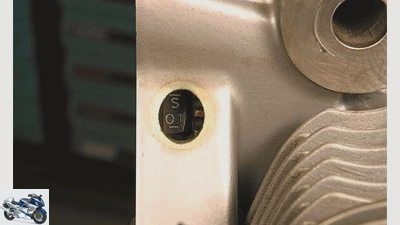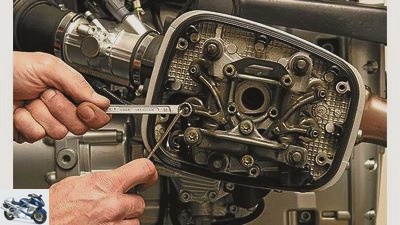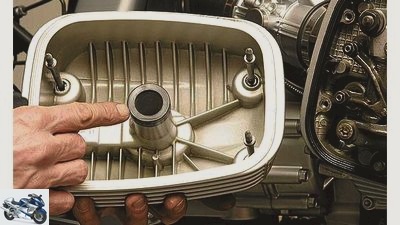Table of contents

Schermer
counselor
workshop
Adjust the valve clearance on the BMW boxer
Screwdriver tip
Adjust the valve clearance on the BMW boxer
Thanks to the exposed cylinder heads, checking and adjusting the valve clearance in the four-valve boxer from BMW is not a big task and can also be done by a hobby mechanic in the garage.
Jorg Lohse
02/15/2012
Valve train
The valve train of the BMW boxer engine of the type R 259 from 1993 onwards consists of several components: Each cylinder has its own, half-height camshaft that is driven by a chain. The cam tracks operate the tappets, which transmit the movement via tappet rods, which in turn act on rocker arms, which operate the valves via adjusting screws.
The engine needs a certain amount of time until the many bearing and contact points have run into each other: camshaft bearings, cam slideway, tappet system on the cam, pushrod head at the bottom of the tappet as well as at the top of the rocker arm, rocker arm bearing (“control carrier” is the name of this assembly at BMW), and adjusting screws Contact part on the ball head (“elephant foot”), valve head, valve seat in the cylinder – there are a whole host of components that have to “sit down”. That is why the first customer service for the boxer engine at 1000 km is one of the most important of all. The screws in the cylinder head are also retightened.
Valve clearance

Schermer
Above, behind the right cylinder, under a rubber stopper, is the viewing hole for setting the top dead center. Turn the pulley on the front of the engine clockwise until the TDC mark appears.
A certain amount of play between the valve head and the valve clearance adjustment screw is necessary so that the valves seal the combustion chamber tightly at all operating temperatures, no gas escapes in an uncontrolled manner and the heat at the valve seat can be dissipated well.
The valve clearance must be checked every 10,000 km (or once a year) and, if necessary, adjusted. The valve clearance must also be checked and, if necessary, corrected when the cylinder head or the control bracket has been removed and reinstalled. The valve clearance is checked and adjusted when the engine is cold (max. 35 degrees, corresponds to lukewarm). Thanks to the free-standing cylinder heads, only a few parts have to be removed.
Check valve clearance
- Place the machine on the center stand and place an oil container under the cylinder head that is to be processed, because oil will run out when the cylinder head cover is removed.
- Unscrew both spark plugs, remove cylinder head cover (“valve cover”). To do this, unscrew the four visible screws. The control carrier is now exposed.
- Search for top dead center (TDC) of the cylinder.
To do this, proceed as follows: At the top right of the motor housing behind the right cylinder is a hole that is closed with a rubber stopper. Pull out this rubber stopper and illuminate the flywheel through the opening with a flashlight. A TDC mark is attached to it, which is searched for by turning the crankshaft.
- TDC search option 1: either engage second or third gear and turn the rear wheel vigorously but slowly until the TDC marking appears in the housing window.
- TDC search option 2: Remove the front cover on the engine (“belt housing cover”) and turn the crankshaft clockwise using the lower screw that holds the belt pulley.
- No matter how you look for the TDC – the TDC control is important, because the piston is only every second rotation in the compression TDC, in which both rocker arms are in the rest position and have some play between the valve adjusting screw and valve head.
- Check valve clearance: Pull feeler gauge between adjusting screw and valve head. Check with different thick feeler gauges until you have found a plate that can be pulled through between the valve head and the valve clearance adjustment screw. This is called the “actual valve clearance”.
Adjust valve clearance

Schermer
When tightening the lock nut, make sure that the valve clearance adjustment screw does not twist.
If the valve clearance is too wide or too tight, it must be corrected. To do this, slightly loosen the lock nut of the valve adjusting screw, screw in or screw out the screw until the valve clearance is correct:
- Inlet valve 0.15 mm
- Outlet valve 0.30 mm
Feeler gauge must grind fully through the gap.
Counter the nut: While doing so, keep the valve adjusting screw in the correct position. Tightening torque of the lock nut 8 Nm.
After countering the nut, check the valve clearance again.

Schermer
Check the sealing ring of the spark plug opening in the cylinder head cover, the valve cover gasket and the rubber sealing washers of the cover screws for porosity before installation. Don’t forget the rubber buffers.
Install valve cover
Place the inner sealing ring on the spark plug opening, put on the valve cover. Check the sealing washers under the retaining screws: Renew if they are “hard” or pitted. Screw in the retaining screws, tightening torque 9 Nm.
Related articles
-
Schoch 20th pictures 1/20 Typical BMW 2V valve train. It looks similar on many other bumper engines. Schoch 2/20 To set the correct valve clearance, the…
-
Screwdriver tip on the subject of valve control
Ralf Petersen 15th pictures Ralf Petersen 1/15 The valve train controls the gas exchange in a four-stroke engine with the help of the inlet and outlet…
-
Advice: check and adjust steering head bearings
Cook 9 pictures Cook 1/9 Checking and adjusting the steering head bearing – Step 2: Loosen the central nut on the steering shaft. Only use a nut and a…
-
Yamaha counselor technology & future Valve control gas exchange PS technology series part 2 Valve control and gas exchange Content of Almost exactly four…
-
BMW HP2 Sport, the production of the sports boxer has been discontinued.
Jahn motorcycles BMW HP2 Sport, the production of the sports boxer has been discontinued. The BMW HP2 Sport Production discontinued: BMW HP2 Sport BMW…
-
Ducati 10 pictures Ducati 1/10 …compact, rotatable hydraulic units on each camshaft, variable timing. The pulse generators for the position of the…
-
Technology development in valve actuation
factstudio.de 23 pictures Katrin Sdun 1/23 Before valve actuation via rocker arms prevailed, numerous other designs determined the state of the art. Ralf…
-
MotoGP technology: valve trains
counselor workshop MotoGP technology: valve trains MotoGP technology: valve trains Sex offender Stoner? Traction control? Tire technology? Happiness? It…
-
New at Wunderlich: Protectors for the BMW Shiftcam Boxer
Motorcycle fair in Milan EICMA 2021 Presented by Whimsical 13th pictures Whimsical 1/13 Wunderlich is offering three new protectors for the BMW Shiftcam…
-
Honda patent new variable valve timing
Honda 12th pictures Honda 1/12 Honda has patented a new variable valve control. Honda 2/12 The new variable valve control in the engine of the upcoming…